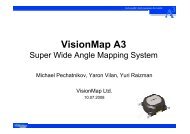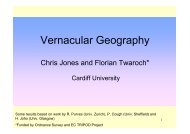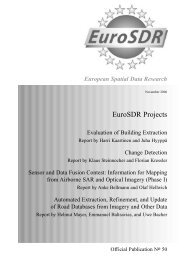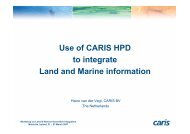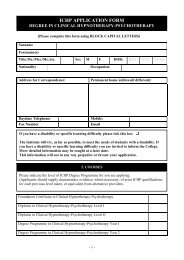European Organization for Experimental ... - Host Ireland
European Organization for Experimental ... - Host Ireland
European Organization for Experimental ... - Host Ireland
You also want an ePaper? Increase the reach of your titles
YUMPU automatically turns print PDFs into web optimized ePapers that Google loves.
• To per<strong>for</strong>m a cost benefit analysis of using High Resolution Sensor imagery versus conventional<br />
methods.<br />
• To investigate the maturity of software system products to exploit automatic land use<br />
classification from High Resolution Sensor imagery.<br />
Three submissions were received <strong>for</strong> Work Package 4 – one final report, one interim report<br />
and one slide presentation. Each of these is reproduced as an annexe.<br />
3.4.2 A summary of the Work Package 4 report by Peter Atkinson and Isabel Sargent,<br />
University of Southampton (Annexe 5)<br />
This report concentrated on the imagery of the Chandlers Ford area of the UK. It utilised<br />
structured large-scale polygon data (the <strong>for</strong>erunner of OS MasterMap) supplied by the Ordnance<br />
Survey. The objective was to classify the area to the CORINE specification. The<br />
study found that the OS MasterMap data is already classified to some extent and that a large<br />
proportion of CORINE classifications could be populated using the in<strong>for</strong>mation already held<br />
in the large-scale polygon data at attribute level. Notwithstanding this conclusion, a classification<br />
of a small subset of the IKONOS imagery was per<strong>for</strong>med, using a maximum likelihood<br />
classifier. Four classes were identified (woodland, smooth grass, rough grass and bare<br />
soil) and the image was classified on a per-pixel basis. The classified pixels were then analysed<br />
on a per-parcel basis; in which each OS MasterMap polygon was assigned the modal<br />
class of all the pixels it contained. In a separate experiment the mean spectral values within<br />
each polygon were used to per<strong>for</strong>m a direct per-parcel classification. Interestingly, these two<br />
methods gave different results – especially when differentiating between rough and smooth<br />
grassland.<br />
The report concludes that a combination of OS MasterMap data and IKONOS imagery could<br />
be used to identify most of the CORINE classes, with the possible exception of ‘mineral<br />
extraction sites’, ‘vineyards’ and ‘pastures’.<br />
3.4.3 A summary of the work package 4 report by Peter Lohmann et al, University of<br />
Hannover - (Annexe 6)<br />
This submission was in the <strong>for</strong>m of a slide presentation, which is reproduced at Annexe 6.<br />
The study concentrated on the multispectral image of the Chandlers Ford area, using ERDAS<br />
Imagine and Definiens eCognition software. Use was made of the OS LandPlan 1:10 000<br />
scale raster data and land use data provided by Hampshire County Council (although it was<br />
noted that this was not based on a CORINE classification). The high resolution of the imagery<br />
was found to introduce new aspects not normally found in multispectral satellite imagery.<br />
One of these is the presence of shadows in the image, which can be used to identify<br />
larger buildings and trees. A second aspect of the high resolution imagery is the heterogeneity<br />
of the image - each land parcel may be made up of several different classes, which would<br />
have been averaged out in lower resolution imagery. The use of the CORINE classification<br />
itself was found to be problematic, in that it caters <strong>for</strong> usage types of natural objects (e.g.<br />
“sport and leisure facilities”) rather than the land cover types (e.g. “grassland”) which can be<br />
determined from the imagery. This was especially the case in urban areas (Annexe 6.2).<br />
The resolution of the imagery was not sufficient to differentiate buildings and streets within<br />
a housing area – it is suggested that the 1m panchromatic imagery would be useful <strong>for</strong> this.<br />
The report concluded that, while high resolution imagery has the potential to permit detailed<br />
classification, new techniques need to be developed to aid the classification process.<br />
24



